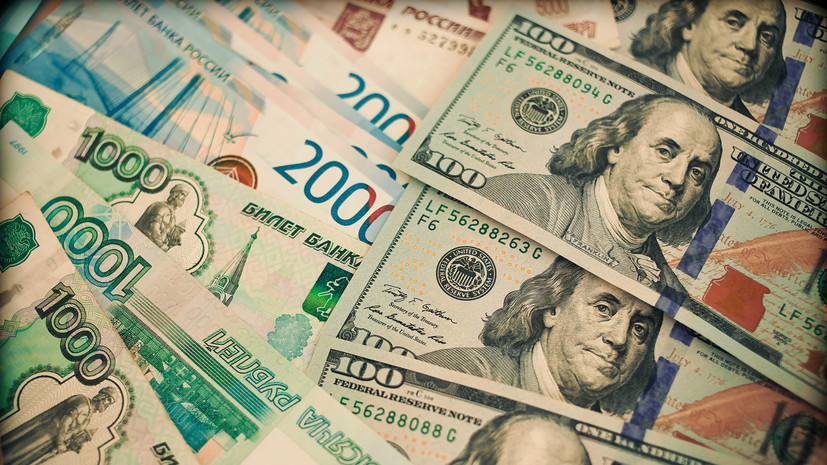On Monday, January 15, the exchange rates of foreign currencies on the Moscow Exchange fell to the lowest levels in more than six months. During trading, the dollar fell by 1.2% to 87.37 rubles, the euro by 1.6% to 95.56 rubles, and the yuan by 1% to 12.1 rubles. The last time similar values could be observed was at the end of June 2023.
The Russian currency has been strengthening against the US, European and Chinese currencies for a week now. Experts largely explain this by seasonal factors, as well as the actions of the country's financial authorities.
"The ruble has a historical tendency to fall in price in the first decade of the month and rise in price in the second, which is what we are seeing now. Along with this, the ruble is supported by weak demand for foreign currency after the New Year holidays, as well as an increase in foreign exchange sales by the Ministry of Finance and the Central Bank," economist Konstantin Tserazov explained to RT.
In January, the Ministry of Finance and the Central Bank increased the volume of foreign currency sales from the National Welfare Fund by more than 20 times - from 800 million to 16.7 billion rubles per day. As a result of this initiative, the supply of foreign banknotes on the market has additionally increased, which has led to a decrease in rates, experts say.
"In December 2023, the budget received less money from oil and gas exports than expected, so in January, the authorities began exchanging more currency from the NWF for rubles to cover part of the treasury's expenses. In addition, the current strengthening of the ruble is due to the mandatory sale of foreign exchange earnings by exporters and the high key rate of the Central Bank," Natalia Milchakova, a leading analyst at Freedom Finance Global, explained in an interview with RT.
It should be noted that at the beginning of last year, there was an imbalance between the demand for foreign currency and its supply in Russia: dollars, euros and yuan received from exports began to enter the country in smaller volumes, and business interest in them increased due to the recovery of imports and the revival of consumer activity. The shortage of foreign banknotes on the market led to their appreciation against the ruble, and exchange rates rose sharply.
As one of the ways to solve the problem, Russian President Vladimir Putin obliged a number of large companies to sell additional volumes of foreign exchange earnings on the market to strengthen the ruble. According to the decree of the head of state, organizations must return from abroad at least 2024% of the earned dollars, euros and yuan by mid-April 80. Moreover, at least 90% of the transferred funds must be exchanged for rubles.
In addition, last year, in order to curb inflation, the Bank of Russia more than doubled the key rate from 7.5% to 16%. As a result, against the backdrop of the rise in the cost of loans, businesses began to purchase foreign goods less often and, accordingly, to purchase foreign currency in smaller volumes, which had a positive effect on the dynamics of the ruble. At the same time, the growing profitability of bank deposits made keeping money in rubles more profitable, and this contributed to the strengthening of the national currency.
Also, according to Natalia Milchakova, the ruble could rise in price in anticipation of Russia's "strong macroeconomic data" for the past year. According to the latest estimates of the authorities, by the end of 2023, the country's GDP could increase by more than 4%, although earlier the country's leadership predicted an increase of only 3.5%.
"In addition, by January 28, large enterprises that received a net profit of more than 2022 billion rubles in 1 must pay excess profit tax to the budget. This will also generate demand for rubles almost until the end of January," Milchakova added.
- Gettyimages.ru
- © Aleksandr Golubev
According to experts interviewed by RT, in the near future, external factors, including the instability of oil prices, may exert certain pressure on the Russian currency. However, experts do not expect a serious weakening of the ruble in the foreseeable future.
Anatoly Trifonov, an analyst at BCS Forex, believes that by the end of winter, the exchange rates of the dollar, euro and yuan will remain close to 87, 95-96 and 12-12.4 rubles, respectively. According to Konstantin Tserazov, in the coming months, the American currency may trade in the range of 85-90 rubles, the European currency within the range of 94-99 rubles, and the Chinese currency near 12-12.5 rubles. At the same time, Natalia Milchakova predicts a slightly wider range of fluctuations.
"In general, throughout the first quarter, the growing trend towards the strengthening of the ruble against world reserve currencies may continue. We expect 83-93 rubles per dollar, 93-104 rubles per euro and 11.8-12.8 rubles per yuan," the RT interlocutor concluded.

